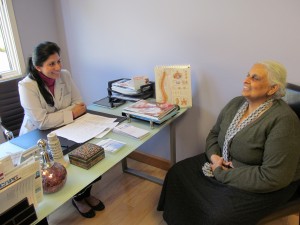When she stopped accepting Medi-Cal and Medicare back in February, her patients had to make a choice: Either they could pay the monthly fee, plus $10 for each office visit, to stay in her practice – or they needed to find a new doctor.
Jayaledchumy Yogaratnam is 76 and has been a patient of Dr. Hisana Qamar’s for three years. She decided to stay. She used to get her care at a clinic that accepted Medicare, but she found her experience there frustrating and would be reluctant to go back. In addition to crowded waiting rooms, she said the wait to see her doctor was long -- “sometimes even 3 hours.”
Yogaratnam also felt rushed by the doctors there, which is not the case with Dr. Hisana Qamar, she says. “It's not like a doctor's office for me - it's just like going to visit someone, visit a friend,” Yogaratnam said. She says she and her family can afford the out-of-pocket expenses, so, for her, staying with the practice is worth the additional cost.
Founder Dr. Samir Qamar says he started this practice model because he wanted people without insurance to have access to low-cost primary care. But for Sophia Chang, an Internal Medicine physician at UC San Francisco and an expert in health care delivery, this model misses the mark.
“It’s clearly the answer to people who have means and essentially want a different tiered system. It’s clearly not the answer if we want to provide population health and if we want to provide good health care to Americans across the board,” said Chang.
One way to understand some of the complications of this model is to follow the money.
Let’s take the example of an uninsured patient with high blood pressure who needs to see her doctor every three months. That’s four primary care visits every year. Under the old model, the patient could visit Dr. Qamar for a flat fee of $99 cash per office visit (remember, she doesn’t have insurance and would be paying out of pocket). So that’s $99 for four visits each year, or $396.
Now, under the MedLion model, the same patient must pay $59 every month, in addition to the $10 fee for each of her four visits. That comes out to $748 dollars per year.
That’s almost double what this uninsured patient would have paid before to see the same doctor.
Under this model, doctors make more money and see fewer patients. That is alluring to many physicians in Northern California, and some doctors in less affluent areas such as Fresno, Watsonville, Salinas, and Bakersfield are already switching their practices to this new format. Once they convert to the MedLion model, they will no longer see patients with Medicare or Medi-Cal, and they will see fewer patients overall – potentially worsening the shortage of primary care doctors in these poorer areas. For those patients who cannot afford to pay the monthly fees, it is unclear where they will seek care.
In addition to spreading the model here in California, Dr. Samir Qamar is consulting with physicians on the east coast to get them on board with this style of practicing medicine. Retainer-based practices like MedLion would be allowed by the Affordable Care Act if patients also have catastrophic insurance to cover things like surgery or chemotherapy, so the cash-only practices could grow in popularity.
